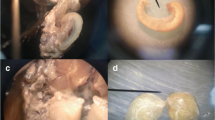Abstract
The responses of red squirrels(Tamiasciurus hudsonicus) and eastern chipmunks(Tamias striatus) to complete and skeleton light-dark (LD) cycles were compared. The skeletons, comprised of two 1-h pulses of light per day, effectively simulated the complete photoperiods in the squirrels, but not the chipmunks. Skeleton photoperiods greater than 12-h caused the chipmunks to shift activity from the longer to the shorter of the two intervals between the pulses. To interpret the mechanism of phase control, squirrels and chipmunks were kept in continuous darkness and exposed to 1-h light pulses every 10 days. The time-course of entrainment was also quantified. Both techniques produced light-response curves. The data suggest that the parametric and non-parametric contributions to entrainment are different in these two rodent species.
Similar content being viewed by others
References
ASCHOFF, J. (1964): Die Tagesperiodik licht- und dunkelaktiver Tiere. Rev. suisse Zool., 71: 528–558.
ASCHOFF, J. (1966): Circadian activity pattern with two peaks. Ecology, 47: 657–662.
CLOUDSLEY-THOMPSON, J. L. (1970): Recent work on the adaptive functions of circadian and seasonal rhythms in animals. J. interdiscipl. Cycle Res. 1: 5–19.
DAAN, S. and PITTENDRIGH, C. S. (1976a): A functional analysis of circadian pacemakers in nocturnal rodents. II. The variability of phase response curves. J. comp. Physiol., 106: 253–266.
DAAN, S and PITTENDRIGH, C. S. (1976b): A functional analysis of circadian pacemakers in nocturnal rodents. III. Heavy water and constant light: homeostasis of frequency? J. comp. Physiol., 106: 267–290.
DECOURSEY, P. J. (1964): Function of a light response rhythm in hamsters. J. cell. comp. Physiol., 63: 189–196.
DECOURSEY, P. J. (1972): LD ratios and the entrainment of circadian activity is a nocturnal and a diurnal rodent. J. comp. Physiol., 78: 221–235.
DECOURSEY, P. J. (1973): Free-running rhythms and patterns of circadian entrainment in 3 species of diurnal rodents. J. interdiscipl. Cycle Res., 4: 67–77.
EDMUNDS, L. N. Jr., FUNCH, R. (1969): Effects of “skeleton” photoperiods and high frequency light-dark cycles on the rhythm of cell division in synchronized vultures ofEuglena. Planta (Berl.), 87: 134–163.
ENRIGHT, J. T. (1965): Synchronization and ranges of entrainment. In: Circadian Clocks. J. Aschoff (ed.), North Holland, Amsterdam, 112–124.
ESKIN, A. (1971): Some properties of the system controlling the circadian activity rhythm of sparrows. In: Biochronomethy. M. Menaker (ed.), Nat. Acad. Sci., Washington, D. C., 55–80.
HOFFMANN, K. (1965): Overt circadian frequencies and circadian rule. In: Circadian Clocks. J. Aschoff (ed.), North Holland, Amsterdam, 87–94.
JUSTICE, K. E. and LUCAS, J. L. (1973): Diurnal foraging in the desert woodrat,Neptoma lepida. Abstract of paper presented at 53rd annual meeting of American Society of Mammalogists.
KRAMM, K. R. (1973a): Experimental prediction for theoretical timing map model, J. interdiscipl. Cycle Res., 4: 361–367.
KRAMM, K. R. (1973b): Photoperiod and entrainment of circadian activity in the antelope ground squirrel. BioScience, 23: 516–522.
KRAMM, K. R. (1975a): Entrainment of circadian activity rhythms in squirrels. Amer. Nat., 109: 379–389.
KRAMM, K. R. (1975b): Circadian activity of the red squirrel,Tamiasciurus hudsonicus, in continuous darkness and continuous illumination. Int. J. Biometeor., 19: 232–245.
KRAMM, K. R. (1976): Phase control of circadian activity in the antelope ground squirrel. J. interdiscipl. Cycle Res. 7: 127–138.
LOCKARD, R. B. (1978): Seasonal change in the activity pattern ofDipodomys spectabilis. J. Mammal., 59: 563–568.
PALMER, J. D. (1976): An Introduction to Biological Rhythms. Academic Press, New York, 1–375.
PAVLIDIS, T. (1969): An explanation of the oscillatory free-runs in carcadian rhythms. Amer. Nat., 103: 31–42.
PAVLIDIS, T. (1973): Biological Oscillators: Their Mathematical Analysis. Academic Press, New York, 1–207.
PITTENDRIGH, C. S. (1960): Circadian rhythms and the circadian organization of living systems. Cold spr. Harb. Symp. quant. Biol., 25: 159–184.
PITTENDRIGH, C. S. (1965): On the mechanism of entrainment of a circadian rhythm by light cycles. In: Circadian Clocks. J. Aschoff (ed.), North Holland, Amsterdam, 277–297.
PITTENDRIGH, C. S. (1966): The circadian oscillation inDrosophila pseudoobscura pupae: a model for the photoperiodic clock. Z. Pflanzenphysiol., 54: 275–307.
PITTENDRIGH, C. S. (1967): Circadian system I. The driving oscillation and its assay inDrosophila pseudoobscura. Proc. Nat. Acad. Sci. 58: 1762.
PITTENDRIGH, C. S. (1974): Circadian oscillations in cells and the circadian organization of multicellular systems. In: The Neurosciences: Third Study Program Vol. 38, F. O. Schmitt and G. O. Worden (ed.), MIT Press, Cambridge, Mass., 437–458.
PITTENDRIGH, C. S. and DAAN, S. (1976a): A functional analysis of circadian pacemakers in nocturnal rodents. I. The stability and lability of spontaneous frequency. J. comp. Physiol., 106: 223–252.
PITTENDRIGH, C. S. and DAAN, S. (1976b): A functional analysis of circadian pacemakers in nocturnal rodents. IV. Entrainment: the clocklike properties of the pacemaker. J. comp. Physiol. 106: 291–331.
PITTENDRIGH, C. S. and DAAN, S. (1976c): A functional analysis of circadian pacemakers in nocturnal rodents. V. Pacemaker complexity: a clock for all seasons. J. comp. Physiol., 106: 333–355.
PITTENDRIGH, C. S. and MINIS, D. H. (1964): The entrainment of circadian oscillations by light and their role as photoperiodic clocks. Amer. Nat., 98: 261–294.
PIVORUN, E. B. (1977): Hibernation of a southern subspecies ofTamias striatus: thermoregulatory patterns. Amer. Midland Nat., 98: 499–503.
POHL, P. (1976): Proportional effect of light on entrained circadian rhythms of birds and mammals. J. comp. Physiol., 112: 103–108.
SAGE, A. P., JUSTICE, K. E. and MELSA, J. L. (1963): Study and research on electronic simulation of the biological clock. II. Tech Doc. Rep. ASD-TDR-63-136. U. S. Air Force, Ohio.
SAUNDERS, D. S. (1977): An introduction to biological rhythms. John Wiley and Sons, New York, 1–170.
SCOTT, G. W. and FISHER, K. C. (1972): Hibernation of eastern chipmunks(Tamias striatus) maintained under controlled conditions. Canad. J. Zool., 50: 95–105.
WEVER, R. (1965): A mathematical model for circadian rhythms. In: Circadian Clocks. J. Aschoff (ed.), Nort Holland, Amsterdam, 112–124.
Author information
Authors and Affiliations
Rights and permissions
About this article
Cite this article
Kramm, K.R., Kramm, D.A. Photoperiodic control of circadian activity rhythms in diurnal rodents. Int J Biometeorol 24, 65–76 (1980). https://doi.org/10.1007/BF02245543
Issue Date:
DOI: https://doi.org/10.1007/BF02245543




